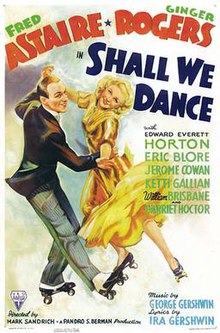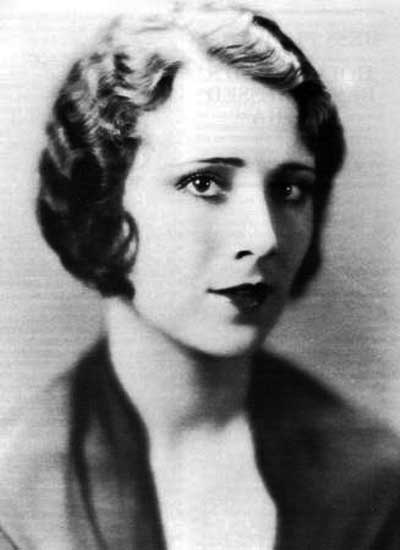My
desert island movie is 1937’s “Shall We Dance.”
Why, certainly.
I’m
not saying it’s the best movie ever made or that it’s even my favorite. It’s
not even the movie I’ve seen the most. That honor would probably be either the
original “King Kong”
or 1957’s “The Spirit of
St. Louis;” which is a mostly-mediocre account of Lindbergh’s transatlantic
flight starring James Stewart, who, despite being 25 years older than Lindbergh
was at the time of the flight, still captures some of Lindy’s boyish charm – a charm
that would later curdle when his pro-Nazi
views came to light. I got hooked on it decades ago when KHJ – Channel 9 in Los
Angeles – showed it on the Million
Dollar Movie, in the days when that meant showing it every weeknight and
two or three times a day on the weekend.
But
if I were to be stranded on a desert island (a la the BBC’s “Desert Island
Discs”), “Shall We Dance” (no question mark) would be the movie I’d chose
to spend my days and nights with. It stars Fred Astaire and Ginger Rogers and features
a score by the Gershwins. It has a great supporting cast, including the
invaluable Edward Everett Horton and Eric Blore. It has my favorite of Astaire
and Rogers’s numbers, “They
All Laughed” (though it’s probably not their best number; that’d be either “Night and Day” from “The
Gay Divorcee,” or “Cheek
to Cheek” from “Top Hat,” or “Never Gonna Dance” from “Swing
Time”).
Any
movie with Horton or Blore is to be welcomed, and having the two of them is always
a treat. At this point, I’d normally sing their praises without introduction,
but (especially after a conversation yesterday where I asked someone if she’d
ever heard of either Imogene
Coca – and got a non-unexpected (though still disappointing) “no” – or the
late Sid
Caesar – another not-unexpected (though surprising in light of his recent
death) “nope”) I realize I must introduce them to some members of my audience.
In
the 30s and 40s, and even into the 50s and 60s, Hollywood was lousy with character actors,
each of whom was an individual “type.” If you wanted a drunk, you hired Jack Norton or Arthur Housman. If you
wanted a likeably hateful bureaucrat, you got Charles Lane. Tough guys
who were actuall pushovers? Allen
Jenkins, Harold
Huber, or George
E. Stone. A kindly (or not so kindly) mother? Beulah Bondi. An old
maid? Elizabeth
Patterson. A vaguely-effeminate desk clerk or salesman? Franklin Pangborn. Sam Levene was a police detective; usually homicide. Robert Emmet O'Connor was a street cop. They
were legion and they were always popping up. They were as solid as rocks and
were instantly identifiable. The queen of them all may have been Bess Flowers. She's less a character actor than a dress extra (though she played plenty of parts), but once you start looking for her, you can't escape her. She had nearly 1,000 credits.
Bess Flowers; just try to miss her in an old movie.
Now
that I think about it, it was a Brechtian approach to casting. One of things Brecht
used was the “gest;” that is, a gesture or piece of acting that acted as an
identifiable shorthand for a personal characteristic. These men and women were
living gests; that is, when you saw Marjorie Main, you knew
her whole background as a crusty old broad who wouldn’t take any nonsense. Seeing
Eve Arden meant you
were going to get a series of dry wisecracks that were driven home with the
skill of Babe Ruth meeting a fat hanging curve. Edward Arnold was a corrupt
businessman. James Gleason
was the seen-it-all New Yorker. Edna Mae Oliver the
snooty society dame with a sense of propriety a mile wide. They were all
likeable – no, loveable – even if they were known only as “That guy!” or
“Oh, her!”
Horton’s specialty in this
arena was fussy bachelors and husbands. Even though he was born in Brooklyn,
you’d have thought he was as English as they come. They read as slightly gay,
but never in a way that would upset the sensibilities of middle America in the
mid-20th century. His characters were always easily upset (which is
why he was hired; for those reactions and takes), but he was stalwart. In his
last years, he was best known for narrating the “Fractured Fairy Tales”
on the “Rocky and Bullwinkle” show. In “Shall We Dance,” he plays the head of
an American ballet company headquartered in Paris, whose premiere danseur
was a Russian named Petrov (Astaire, natch) who was, in actuality Peter P.
Peters from Philadelphia. (Don’t ask. That’s how movies were plotted in 1937.)
"Linda Keane" and "Petrov."
Blore was English and
always played butlers or waiters. He specialized in outraged takes and mugging.
His character was usually easily confused and struggling to keep up with the
plot. (There are exceptions, of course; in “The Lady Eve,” he’s a sharp con
man.) In reading up on him just now, I found this anecdote on his IMDb
biography: “As sometimes is the case when personalities move into
obscurity, their deaths are prematurely announced. Such was with Blore when The New Yorker journalist Kenneth Tynan
reported him as already passed on. Blore's lawyer raised a flurry, as did the editor
of The New Yorker, who claimed the
periodical had never had to print a retraction. The night before the highly-profiled
retraction appeared, Blore indeed passed away. And the next morning, The New Yorker was the only publication
with the wrong information. It seems like Blore would have been particularly
tickled with the irony of this last comedic bit in honor of his passing.” In “Shall
We Dance,” he plays Cecil Flintridge, the floor manager of a barely-disguised
Waldorf-Astoria.
Blore looking frustrated; his usual state.
Horton and Blore share three
particular scenes in “Shall We Dance.” The first is their meeting in the hotel.
Their refusal to understand one another is a microcosm of the picture as a
whole;; where everyone willfully ignores what everyone else has just done or
said. One is what we’ve come to call “Susquehanna Street.” For
various plot reasons (again, don’t ask), Blore is arrested for assaulting a
process server. He calls Horton’s character to bail him out, and the two again
misunderstand each other as Blore’s attempts to spell “Susquehanna” only lead
them into a black hole of confusion. The last is a scene where they have a loud conversation
in the rear of a nightclub audience that causes the other patrons to shush
them. They shush the audience back, leading to a veritable parade of takes and
garbagey reactions.
Horton looking outraged; his usual state.
As usual, I’ve gotten
carried away and gotten away from my original point – which is actually fortunate,
as I’ll explain tomorrow – but to get there will take many more words than are
worth spending right now, but which will be next time.





No comments:
Post a Comment